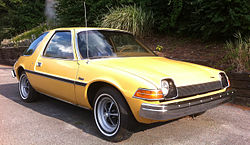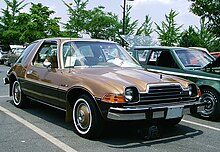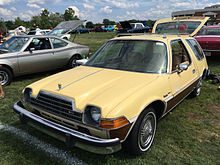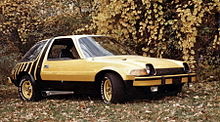AMC Pacer
| AMC | |
|---|---|
|
AMC Pacer (1975-1979)
|
|
| Pacer | |
| Production period: | 1975-1979 |
| Class : | Compact class |
| Body versions : | Station wagon , station wagon |
| Engines: |
Petrol engines : 3.8-5.0 liters (67-98 kW) |
| Length: | 4320-4420 mm |
| Width: | 1960 mm |
| Height: | 1339-1349 mm |
| Wheelbase : | 2540 mm |
| Empty weight : | 1158-1543 kg |
The AMC Pacer is a three-door compact car manufactured by American Motors Corporation (AMC) and was built from February 1975 to December 1979. In the spring of 1977, was still wagon version Station Wagon introduced. The factory code was Series 60 .
Because of its idiosyncratic appearance and large glass surfaces, the Pacer is one of the most bizarre automobiles and has also been referred to as a rolling aquarium , football on wheels and a large frog . It now has cult status and is a collector's item.
history
On November 10, 1970, General Motors acquired the license to build rotary engines , which were to be supplied to AMC, among others, for the development of a new compact car with a cab-forward design . At the beginning of 1971, AMC's chief designer Richard Teague began with the first designs for a spacious small car. We experimented with different arrangement variants for the engine and the seat arrangement, such as B. with a central engine , a bench against the direction of travel or an asymmetrical engine arrangement. In addition, consideration was given to implementing the front-wheel drive concept, which is increasingly being used in Europe, for the American market.
The decision in favor of a front Wankel engine with rear-wheel drive was made relatively late, so that the basic design was based on a Wankel engine with front-wheel drive. Apparently, standard gearboxes of the AMC models and rear axles of the AMC Matador should be used to save costs . This decision, however, considerably restricted the capacity of the trunk and limited the rear row of seats to two seats through the cardan tunnel.
In January 1972, a clay model of the Pacer was examined by internal experts and received positively. A year later, the fiberglass prototype was presented in Dallas alongside the 73 models of the AMC Hornet and Gremlin . The emissions laws that had just been passed and the oil crisis ensured that GM dropped the use of the smooth-running but thirsty rotary engine shortly before production of the Pacer began.
Although AMC had acquired its own license for the Wankel engine in February 1973, conventional engines were ultimately used. Square was to use the in-house by alterations in the engine compartment rows - six-cylinder engine - engine provided which drive the rear axle. In the mid-1970s, a new bill was presented to the US Senate that tightened the safety regulations for car models from 1980 onwards. The designers of the Pacer provided the US compact car, the safest for its time, with a windshield made of laminated glass , a particularly rigid body with a stable B-pillar and doors with side impact protection . The front passenger door was a good 10 cm (almost 4 inches ) longer than the driver's door to make it easier to get into the back seat . Thanks to the generous glass surfaces, the clarity of the Pacer was above average. A massive roll bar was also planned, but it turned out to be no longer necessary due to largely defused laws. The design in the rear area nevertheless allowed a shorter vehicle length and reduced weight.
The development costs of the Pacer amounted to 60 million US dollars .
technology
The basic engine of the Pacer consisted of the 3.8 liter six-cylinder 232 in connection with a manual gearbox that was operated on the steering wheel. As an option, the 4.2-liter six-cylinder 258 , known from the Jeep , was added in the first model year and was available with a single or double carburetor. As an option, there was the Torque Command automatic transmission (bought, actually Chrysler TorqueFlite). From 1978 the smallest of the AMC V8 engines , 304 with a 5 liter displacement, was also available.
The technical features also included one of the first applications of rack and pinion steering in a US high-volume model.
The length of the vehicle was the same as that of a VW Golf IV , and its width still exceeds that of the Mercedes-Benz S-Class . Accordingly, the Pacer was advertised with the slogan “The first wide small car”. The optional air conditioning was recommended because of the large glass surfaces. The opening of the heavy tailgate was supported by two gas pressure springs.
Due to the particularly wide track width (1,550 mm at the front, 1,529 mm at the rear) and the low center of gravity , the Pacer was relatively stable. Only the heavy top-heaviness could lead to the rear breaking out when braking hard.
In the USA there was the usual long list of equipment; Vehicles for the European market received significantly better basic equipment. Other options were other manual transmissions , the aforementioned automatic transmission, radios with simple equipment and with eight-track tape and compact cassette drives. The range of paintwork and interior fittings was also extensive.
When it was launched, there was a Pacer X and Pacer D / L version in addition to the basic Pacer model.
Engines
- 3.8 liter R6, 90-91 hp (67-68 kW); Model years 1976–1978
- 4.2 liter R6, 97-122 hp (72-91 kW); all model years
- 5.0 liter V8, 126-132 hp (91-98 kW); Model years 1978–1979
production
1975 and 1976
The Pacer was on sale from March 1, 1975, and in the year of its launch, 145,528 units, more than twice as many Pacers as Gerry Meyers had forecast in January 1975.
The vehicles produced in 1975 were assigned to the 1976 model year and were given the model number 7666-7 (the first two digits indicate the model year). In 1976, despite declining sales, the Pacer still accounted for more than 40% of total AMC production with 117,244 units. The Pacer was available in the basic configuration from $ 3,499 with the 3.8 liter (232 in³ ) engine, three-speed steering wheel gearshift and drum brakes without brake booster on all wheels. However, the Pacer was rarely ordered in this configuration. On average, buyers spent around $ 5,000 on a Pacer, mostly in connection with the X or D / L package at 339 or 199 dollars. Both packages also included a front stabilizer . The customer could upgrade his Pacer with additional equipment packages, for example for better insulation or better handling (called the "rally" package) and various extras. The safety equipment of all AMC models included, in addition to the mandatory energy-absorbing bumpers at the front and rear, among other things, an energy-absorbing steering column, neck rests in the front seats, hazard warning lights and reversing lights. All engines had electronically controlled ignition systems.
The more powerful 4.2 l (258 in³) engine as well as power steering , disc brakes , brake booster, air conditioning and automatic transmission were the most popular additional equipment. Some colors were only available for the Pacer.
1977
At the beginning of 1977 AMC presented the station wagon version of the Pacer, which was developed for 12 million dollars and was intended as an answer to the new station wagons of the Chrysler K series . For Teague, this was "one of the easiest projects" he had ever worked on. The wagon was identical to the normal hatchback up to the B-pillar , but received a conventionally designed rear section with a 10 cm longer overhang. This increased the trunk of the station wagon by 50% to 1,350 liters with only 33 kg more weight than the Pacer Hatchback. The tailgate reached to the bumper. In the D / L equipment, the wagon received decorative foils with imitation wood on the flanks and on the rear. The introduction of the wagon did not lead to an increase in sales, but from the start of sales, more copies of the station wagon version were sold than of the hatchback sedan, which showed the importance of the model expansion. The AMC six-cylinder engines received redesigned combustion chambers, and front disc brakes were now part of the basic equipment of all AMC vehicles. 20,265 Pacer Hatchback model 7766-7 and 37,999 wagon model 7768-7 were sold, the base prices were 3649 and 3649 respectively. 3799 dollars.
1978
In 1978 the Pacer received a modified front with an enlarged radiator grille, which was mainly due to the newly available V8 engine, which did not fit under the previous bonnet. It was only available in the 5.0 l (304 in³) version with 130 hp (97 kW) at 3200 rpm. The "X" package was omitted. The prices continued to rise. The Pacer Hatchback Model 7866-7 now priced at $ 4,048 (from $ 4,298 with V8) and the Wagon Model 7868-7 from $ 4,193 (from $ 4,443 with V8). Sales fell to 7,411 hatchbacks and 13,820 wagons.
1979
In the course of the model renewal, the Gremlin was replaced by the Spirit in 1979 , which increased the pressure on the Pacer. Outwardly only distinguishable from the previous model by a new hood ornament, the Pacer now received the 4.2 liter as the base engine. There was new for all AMC models a basic version "DL" and the upscale "Limited" equipment, which includes power steering, electric windows, leather seats, AM radio, two externally adjustable exterior mirrors, a folding center armrest and a softer one Carpet included. The V8 was only available in conjunction with power brakes and power steering.
Prices were: Pacer Hatchback (Model 7966-7) DL from $ 4,699 (from $ 5177 with V8), Limited from $ 5699 (from $ 6177 with V8); Pacer Wagon (model 7968-7) DL starts at $ 4,849 (starts at $ 5,327 with V8), Limited starts at $ 5849 (starts at $ 6,327 with V8). 10,215 Pacers were sold, 1,014 of them with V8s.
1980
For 1980 the Pacer underwent only a few visual changes. The V8 option was omitted. Prices were: Pacer Hatchback (Model 8066-7) DL from $ 5407, Limited from $ 6031; Pacer Wagon (Model 8068-7) DL from $ 5,558, Limited from $ 6,182.
Production of the Pacer ended prematurely on December 3, 1979, and sales continued until the beginning of 1980. A total of 1746 copies were sold, of which 1341 were the station wagon. With only 405 vehicles sold, the 1980 model year hatchback is the rarest Pacer model ever.
The consumption of 22 MPG (miles per gallon), around 10.7 l / 100 km, was no longer attractive to buyers of smaller vehicles during the second oil crisis , and the massive increases in prices had a negative impact on sales.
Special models
Between 1976 and 1979 the Mexican Vehiculos Automotores Mexicanos (VAM) also built the Pacer with a six-cylinder bored to 4621 cm³ (282 in³), which was intended exclusively for the hatchback model with 174 hp.
AMC showed the Pacer "Stinger" with matt black and yellow effect paint at US auto shows in 1976. The vehicle had an additional air inlet on the bonnet, front spoiler, side exhaust system, widened wheel arches to accommodate the “Jackman Star” aluminum wheels and inside a black and yellow upholstery with individual seats and console switch.
The AMC dealer Randall from Mesa ( Arizona ) - specialist in AMC muscle cars - took on a Pacer small series with the 6571 cm³ (401 in³) V8 engine. The original AMC engine with 401 in³ (6.6 liters) displacement and 215 hp was tuned by Mike Randall with, among other things, Edelbrock intake manifold , # 310 camshafts and a 600 cfm Holley quadruple carburetor. Randall gave 300+ hp as output and 9.5 mpg (24.7 liters per 100 km) as consumption.
Movie and TV
- In the French film Breast or Keule from 1976, the son ( Coluche ) of restaurant critic Charles Duchemin ( Louis de Funès ) drives a Pacer X.
- In the 1977 film Oh God ... John Denver drives a Pacer Wagon.
- In the David Byrne film True Stories (1986), John Goodman drives a green Pacer.
- A blue Pacer can be seen in Sylvester Stallone's 1986 film Cobra .
- In the road movie Crossroads - Pact with the Devil , a Pacer stands on a junk heap in the junkyard.
- In an episode of the television series Golden Girls , Sophia Petrillo announced to her daughter Dorothy : "You are the biggest misstep that has ever stepped on a street since the AMC Pacer!"
- In the 1992 movie Wayne's World , Wayne Campbell ( Mike Myers ) and Garth Algar ( Dana Carvey ) drive a licorice stick dispenser, light blue, flame-adorned Pacer they call the Mirth Mobile . In Wayne's World 2 from 1993, the rock group Aerosmith drives up with a super-stretched pacer with double rear axles, additional doors and the inscription Mirthlimo 1 .
- In the episode Dark Horizon (1994) of the science fiction television series Alien Nation , a Tenctonian owner of a yellow Pacer Station Wagon, which also turns out to be the scene of a crime.
- In Goofy - The 1995 Film , Goofy drives a Pacer.
- The 1997 film Good Burger shows a Pacer converted into a burger mobile .
- In Men in Black II , a black Pacer can be seen in the opening credits of the film, Mysteries in History .
- In the 2004 movie Starsky & Hutch, the two main characters are shot from a red Pacer.
- In the Icelandic independent film A Little Trip to Heaven from 2005, main actor Forest Whitaker drives a somewhat shabby Pacer.
- In his seven-minute video Tell (2007/08), the Austrian artist Erwin Wurm lets a pacer drive up a vertical house wall.
- In Leander Haußmann's film Robert Zimmermann Wonders About Love from 2008, the eponymous hero, played by Tom Schilling, drives a white AMC Pacer Wagon.
- In 2009 Adventureland , Emily "Em" (Kristen Stewart) drives a Pacer.
- In the movie Friendship! (2010) Veit and Tom ride as hitchhikers in a Pacer Station Wagon.
- In the 2010 film StarStruck - The Star Who Loved Me, a pink Pacer sinks into the mud after an odyssey.
- In the music video for the 2010 single Happiness by the US singer Alexis Jordan , a Pacer is one of the main scenes.
- In the 2011 Pixar animation film Cars 2 , several Pacers can be seen as villains.
- In the film In the Deep Valley of the Superbabes , a Pacer serves as a pizza taxi.
literature
- John A. Gunnell: Standard Catalog of American Motors, 1902-1987 ; Krause Publications Iola WI, 1st edition, 1993; ISBN 0-87341-232-X .
- Charles K. Hyde: Storied Independent Automakers: Nash, Hudson, and American Motors. Wayne State University Press, Detroit, Great Lakes Books Series, 2009; ISBN 978-0-8143-3446-1 .
- Larry G. Mitchell: Illustrated AMC Buyer's Guide , Motorbooks International (1994); ISBN 0-87938-891-9 .
- John A. Gunnell (Ed.): Standard Catalog of American Cars 1946-1975. 4th revised edition. Krause Publications, Iola WI, 2002; ISBN 0-87349-461-X .
- Richard M. Langworth (Ed.): Encyclopedia of American Cars from 1930 ; Consumer Guide, Publications International, 1993; ISBN 0-7853-0175-5 .
- Tad Burness: American Car Spotter's Guide, 1966-80 ; Motorbooks International, ISBN 0-87938-102-7 .
Web links
- The Pacer Page : US website with a lot of information, accessed August 10, 2017
- www.pacer.at : illustrated German-language website, also with information on the procurement of spare parts, accessed on August 10, 2017
- Let the sun shine in - Tin of the Week (49): AMC Pacer . In: Süddeutsche Zeitung (SZ) of April 9, 2009 (online version of May 17, 2010); accessed on August 10, 2017
- AMC catalogs at oldcarbrochures.org , including Pacer, accessed on August 10, 2017
- The Unfortunate History of the AMC Pacer (video on YouTube)
Individual evidence
- ↑ a b c d e f g h i j k l Gunnell: Standard Catalog of American Motors, 1902-1987 , 1993; P. 250
- ↑ Quentin Willson: Classic Dream Cars. Dorling Kindersley Verlag, Munich 2008, ISBN 978-3-8310-9072-3 , p. 35.
- ^ A b Gunnell: Standard Catalog of American Motors, 1902-1987 , 1993; P. 251
- ^ A b c d e f Gunnell: Standard Catalog of American Motors, 1902-1987 , 1993; P. 252
- ^ A b Gunnell: Standard Catalog of American Motors, 1902-1987 , 1993; P. 256
- ^ Gunnell: Standard Catalog of American Motors, 1902-1987 , 1993; P. 255
- ^ A b Gunnell: Standard Catalog of American Motors, 1902-1987 , 1993; P. 257
- ^ Gunnell: Standard Catalog of American Motors, 1902-1987 , 1993; P. 259
- ^ A b Gunnell: Standard Catalog of American Motors, 1902-1987 , 1993; P. 260
- ↑ wardsautoworld.com "22 years ago" ( Memento of the original from July 28, 2011 in the Internet Archive ) Info: The archive link was inserted automatically and has not yet been checked. Please check the original and archive link according to the instructions and then remove this notice. Retrieved March 29, 2010
- ↑ Fig. In the exhibition catalog Erwin Wurm, Städtische Galerie im Lenbachhaus, Munich 2009, pp. 282–285












